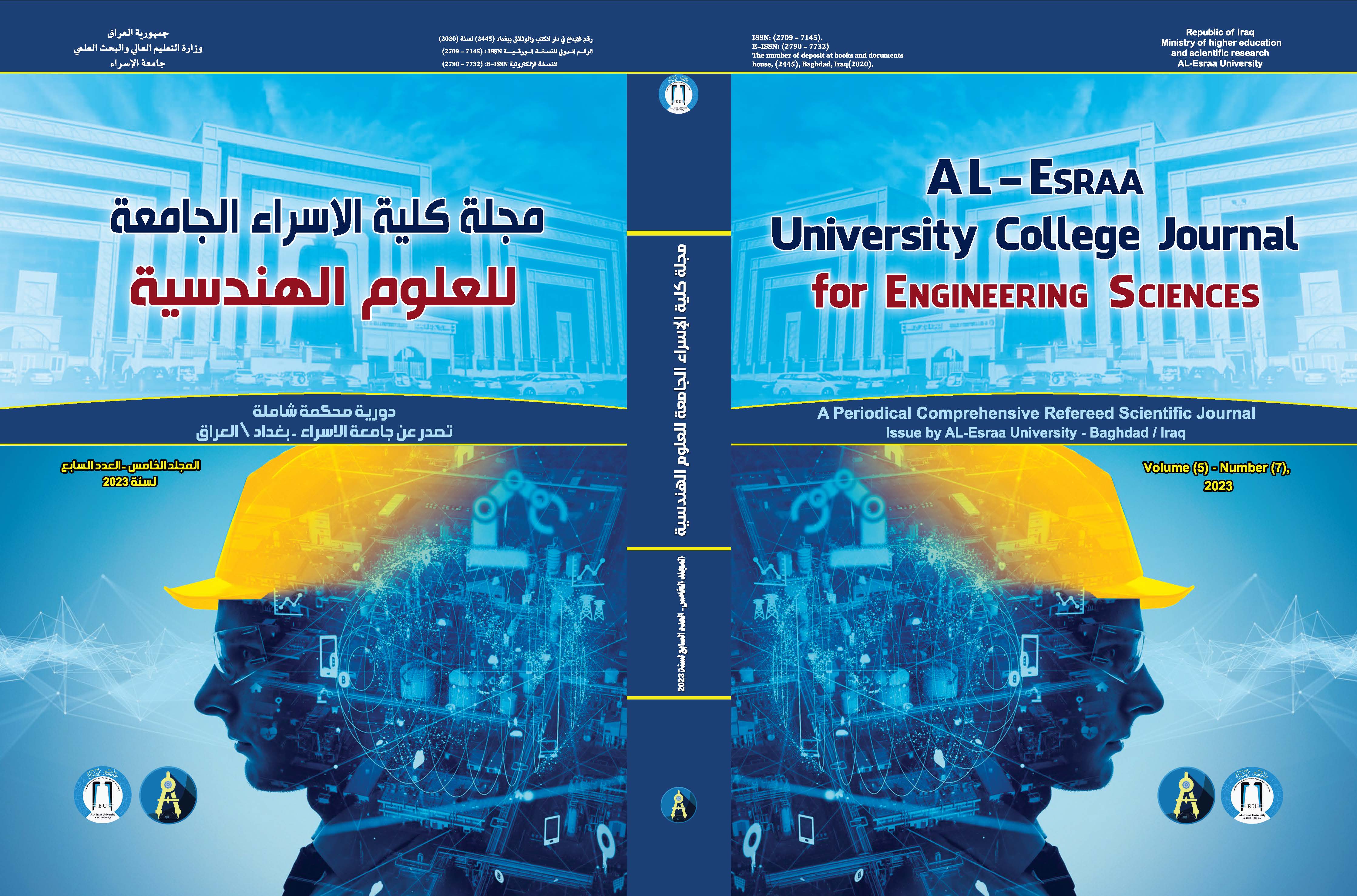Abstract
Architecture has sought since time immemorial to meet multiple human
needs, starting from the basic physiological needs for human survival, psychological
needs (social and individual) to needs related to human progress, such as taking
into account the aesthetic and spiritual aspects, which represent the highest levels
of those needs, through a set of design aspects and characteristics.. This research is
based on the study of the spiritual dimension of higher human needs in general that
architecture seeks to meet, by studying that in the architecture of traditional cities,
in particular, to enhance architectural knowledge with regard to the importance of
investing its capabilities in reconstruction to ensure the creation of contemporary
architecture with privacy and identity, so the problem was identified In light of this,
in connection with the local reality in terms of the limited knowledge discourse
about the investment of the most important aspects and design characteristics
of what is known as spiritual architecture in reconstruction, in general, and in the
reconstruction of the ancient city of Mosul in particular, the goal of the research
is to provide clear knowledge of those aspects and characteristics associated with
spiritual architecture. The religious and civil secular ones in terms of their sensory,
material, aesthetic, and natural environment levels. The research has adopted
the descriptive approach in analyzing theoretical propositions to formulate a
theoretical proposition that paves the way for basic steps that can be adopted
during reconstruction and investigated in two case studies of the architecture of the
ancient city of Mosul, especially after what it was exposed to. Most of the religious
and civil buildings of historical value were destroyed within their urban areas.
needs, starting from the basic physiological needs for human survival, psychological
needs (social and individual) to needs related to human progress, such as taking
into account the aesthetic and spiritual aspects, which represent the highest levels
of those needs, through a set of design aspects and characteristics.. This research is
based on the study of the spiritual dimension of higher human needs in general that
architecture seeks to meet, by studying that in the architecture of traditional cities,
in particular, to enhance architectural knowledge with regard to the importance of
investing its capabilities in reconstruction to ensure the creation of contemporary
architecture with privacy and identity, so the problem was identified In light of this,
in connection with the local reality in terms of the limited knowledge discourse
about the investment of the most important aspects and design characteristics
of what is known as spiritual architecture in reconstruction, in general, and in the
reconstruction of the ancient city of Mosul in particular, the goal of the research
is to provide clear knowledge of those aspects and characteristics associated with
spiritual architecture. The religious and civil secular ones in terms of their sensory,
material, aesthetic, and natural environment levels. The research has adopted
the descriptive approach in analyzing theoretical propositions to formulate a
theoretical proposition that paves the way for basic steps that can be adopted
during reconstruction and investigated in two case studies of the architecture of the
ancient city of Mosul, especially after what it was exposed to. Most of the religious
and civil buildings of historical value were destroyed within their urban areas.
Keywords
Reconstruction
Spiritual architecture
Supreme human needs
Traditional architecture in Mosul.
Abstract
تسعى العمارة منذ الازل إلى تلبية الاحتياجات الانسانية المتعددة، بدءًا من
الاحتياجات الفسيولوجية الأساسية لبقاء الإنسان، والاحتياجات النفسية (الاجتماعية
والفردية) إلى الاحتياجات المرتبطة بالتقدم البشري، مثل مراعاة الجوانب الجمالية
والروحية، التي تمثل المراتب العليا لتلك الاحتياجات، من خلال مجموعة من الجوانب
والخصائص التصميمية. يقوم هذا البحث على دراسة البعد الروحي من الاحتياجات
الانسانية العليا بشكل عام والتي تسعى العمارة لتلبيتها، ودراسة ذلك في عمارة المدن
التقليدية، على وجه الخصوص، لتعزيز المعرفة المعمارية فيما يتعلق باهمية استثمار
امكانياتها في اعادة الاعمار وبما يضمن ايجاد عمارة معاصرة ذات خصوصية وهوية،
فتحددت المشكلة البحثية في ضوء ذلك وبما يرتبط والواقع المحلي من حيث محدودية
الطرح المعرفي حول استثمار اهم الجوانب والخصائص التصميمية لما يعرف بالعمارة
الروحية في اعادة الاعمار، عموما، وفي اعادة اعمار مدينة الموصل القديمة بالخصوص،
وتحدد هدف البحث بتقديم المعرفة الواضحة لتلك الجوانب والخصائص المرتبطة بالعمارة
الروحية الدينية منها والعلمانية - المدنية من حيث مستوياتها الحسية والمادية الجمالية
والبيئة الطبيعية، وقد اعتمد البحث المنهج الوصفي في تحليل الطروحات النظرية لصياغة
طرح نظري يمهد لوضع خطوات اساسية يمكن اعتمادها عند اعادة الاعمار وتقصيها في
دراسة حالتين لعمارة مدينة الموصل القديمة وبالاخص بعد ما تعرضت اليه من دمار كبير
طال اغلب المباني الدينية والمدنية ذات القيمة التاريخية ومناطق تواجدها حضرياً.
الاحتياجات الفسيولوجية الأساسية لبقاء الإنسان، والاحتياجات النفسية (الاجتماعية
والفردية) إلى الاحتياجات المرتبطة بالتقدم البشري، مثل مراعاة الجوانب الجمالية
والروحية، التي تمثل المراتب العليا لتلك الاحتياجات، من خلال مجموعة من الجوانب
والخصائص التصميمية. يقوم هذا البحث على دراسة البعد الروحي من الاحتياجات
الانسانية العليا بشكل عام والتي تسعى العمارة لتلبيتها، ودراسة ذلك في عمارة المدن
التقليدية، على وجه الخصوص، لتعزيز المعرفة المعمارية فيما يتعلق باهمية استثمار
امكانياتها في اعادة الاعمار وبما يضمن ايجاد عمارة معاصرة ذات خصوصية وهوية،
فتحددت المشكلة البحثية في ضوء ذلك وبما يرتبط والواقع المحلي من حيث محدودية
الطرح المعرفي حول استثمار اهم الجوانب والخصائص التصميمية لما يعرف بالعمارة
الروحية في اعادة الاعمار، عموما، وفي اعادة اعمار مدينة الموصل القديمة بالخصوص،
وتحدد هدف البحث بتقديم المعرفة الواضحة لتلك الجوانب والخصائص المرتبطة بالعمارة
الروحية الدينية منها والعلمانية - المدنية من حيث مستوياتها الحسية والمادية الجمالية
والبيئة الطبيعية، وقد اعتمد البحث المنهج الوصفي في تحليل الطروحات النظرية لصياغة
طرح نظري يمهد لوضع خطوات اساسية يمكن اعتمادها عند اعادة الاعمار وتقصيها في
دراسة حالتين لعمارة مدينة الموصل القديمة وبالاخص بعد ما تعرضت اليه من دمار كبير
طال اغلب المباني الدينية والمدنية ذات القيمة التاريخية ومناطق تواجدها حضرياً.
Keywords
الاحتياجات الانسانية العليا، العمارة الروحية، اعادة الاعمار، العمارة التقليدية في الموصل.
